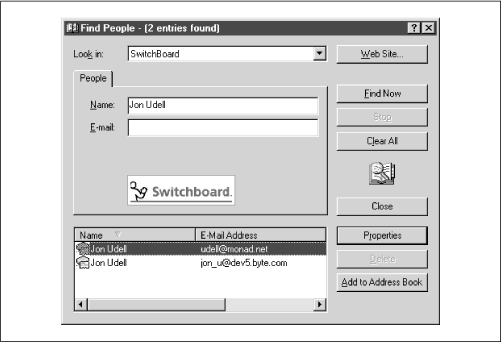The LDAP Consensus
One of the first tangible outcomes of the LDAP consensus appeared in the Netscape and Microsoft 4.x browsers. Although many users still don’t realize it, both products’ email address books—along with the browsers themselves—are LDAP clients. That wouldn’t have meant much if there were no LDAP servers to talk to. Fortunately all the major web-based email directories—including Four11, Switchboard, and WhoWhatWhere—immediately adapted their services to respond to LDAP queries. Suddenly, for the first time, you could ask the Internet—straight from your mail client—for Jon Udell’s email address, as shown in Figure 11.1.

Figure 11-1. Looking up an email address in Outlook Express
Internet novices found this unremarkable. Hadn’t the Internet always worked this way? Well, no, actually it hadn’t. Given the politics and inertia that had long plagued Internet-directory efforts, it was a pleasant surprise when the pieces came together as quickly and easily as they did in 1997.
Internet enthusiasts like to say that it’s easier to adapt technologies proven on a global scale for use on local networks than to adapt LAN technologies for global use. In terms of scalability and interoperability that’s true, but companies will for some time continue to rely on LAN-based file, print, and directory services. Here too the influence of LDAP is strong. Novell’s X.500-derived NDS will be accessible ...
Get Practical Internet Groupware now with the O’Reilly learning platform.
O’Reilly members experience books, live events, courses curated by job role, and more from O’Reilly and nearly 200 top publishers.

